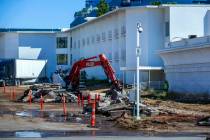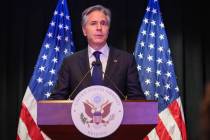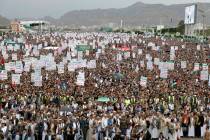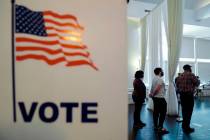PERS has lost 19 percent on its investments since July 1
CARSON CITY — The Public Employees Retirement System has lost more than $4 billion on its investments since July, according to system executives who also told Nevada legislators today that they cannot legally cut benefits to existing participants.
PERS investment officer Ken Lambert said the value of the system’s retirement fund has dropped 19 percent since July 1. On that date, the fund stood at $22.2 billion. As of Friday, it had fallen to $18 billion because of the decline in the stock market.
Even with the drop, Lambert said Nevada’s investments actually have performed in the top 10 percent of major pension funds. He said the Standard & Poor’s 500-stock index has lost 37 percent of its value since July.
About 55 percent of the retirement system’s investments are in domestic and foreign stock.
“Of course, we are concerned,” PERS executive officer Dana Bilyeu said. “This is a significant recession we are in. But we look at things on a very long-term basis.”
They spoke during a meeting of the Legislature’s Retirement and Benefits Committee.
The goal among PERS’ managers is to average an 8 percent annual increase in the fund. Since 1984, it has averaged an annual gain of 10.2 percent.
Even more than the loss of investment income, Bilyeu said PERS has been negatively affected financially by the increased longevity of its members.
The average firefighter or police officer in Nevada retires at age 55 and lives into his or her mid-80s, collecting up to 30 years of benefits along the way, she said.
Regular employees usually retire at age 60 and secure benefits until they die in their 80s.
By contrast, Social Security pays reduced retirement benefits at age 62. Most people on Social Security retire at 65 or 66 and then secure full benefits.
PERS benefits average $27,692 per year.
Both state Sens. Bill Raggio, R-Reno, and Bob Coffin, D-Las Vegas, told Bilyeu that Nevada faces severe budget problems and steps must be taken to reduce state contributions.
They questioned whether the system would save on benefit costs by increasing the retirement age to 65.
That might well save money, Bilyeu said, but state and federal laws prevent any reductions in benefits — including increasing the retirement age — to existing participants in PERS.
“We are going to have to revisit the way we contribute,” Raggio said. “This cost is driving us crazy.”
Coffin said legislators will have to raise taxes in 2009 to balance the budget. Before they do that, though, he said they must show they have taken all steps to reduce spending.
Bilyeu did say that they could cut benefits or increase the retirement age for any employees hired after an enabling law was passed.
A bill to change PERS to a 401k type retirement plan for newly hired employees is being drafted by Assemblyman Ty Cobb, R-Reno, for consideration by the 2009 Legislature.
Public employees now can retire after 30 years and receive benefits equivalent to 75 percent of their average earnings during their three best pay years. Police and firefighters receive these benefits after 25 years on the job. Some retire at age 46.
The system provides retirement benefits to 37,000 retired public employees. About 104,000 current public employees are active members of the system.
Bilyeu wants to increase contributions paid for retirement of normal employees to 21.5 percent of their pay starting next July. That rate now is 20.5 percent. The employee and state or local government each pay half of this cost. The rate is up 3 percentage points since 2000.
For police and firefighters, the new contribution rate would be 37 percent, up from 33.5 percent.
The state budget office could not be reached for comment on the effect of that increase.
Although costs are increasing, Bilyeu pointed out that a Las Vegas Chamber of Commerce study in the summer found government in Nevada pays the seventh lowest percentage in the nation for employee retirement benefits.
She said that is because government in 42 states pays for a pension plan as well as Social Security costs. In Nevada, state and local governments do not pay into Social Security.
Bilyeu said the retirement costs for public employees in the United States average slightly more than 28 percent of each employee’s earnings, about 7 percentage points higher than Nevada.
The chamber study also showed Nevada has the fewest number of public employees per capita in the nation.
Contact Capital Bureau Chief Ed Vogel at evogel@reviewjournal.com or 775-687-3901.























